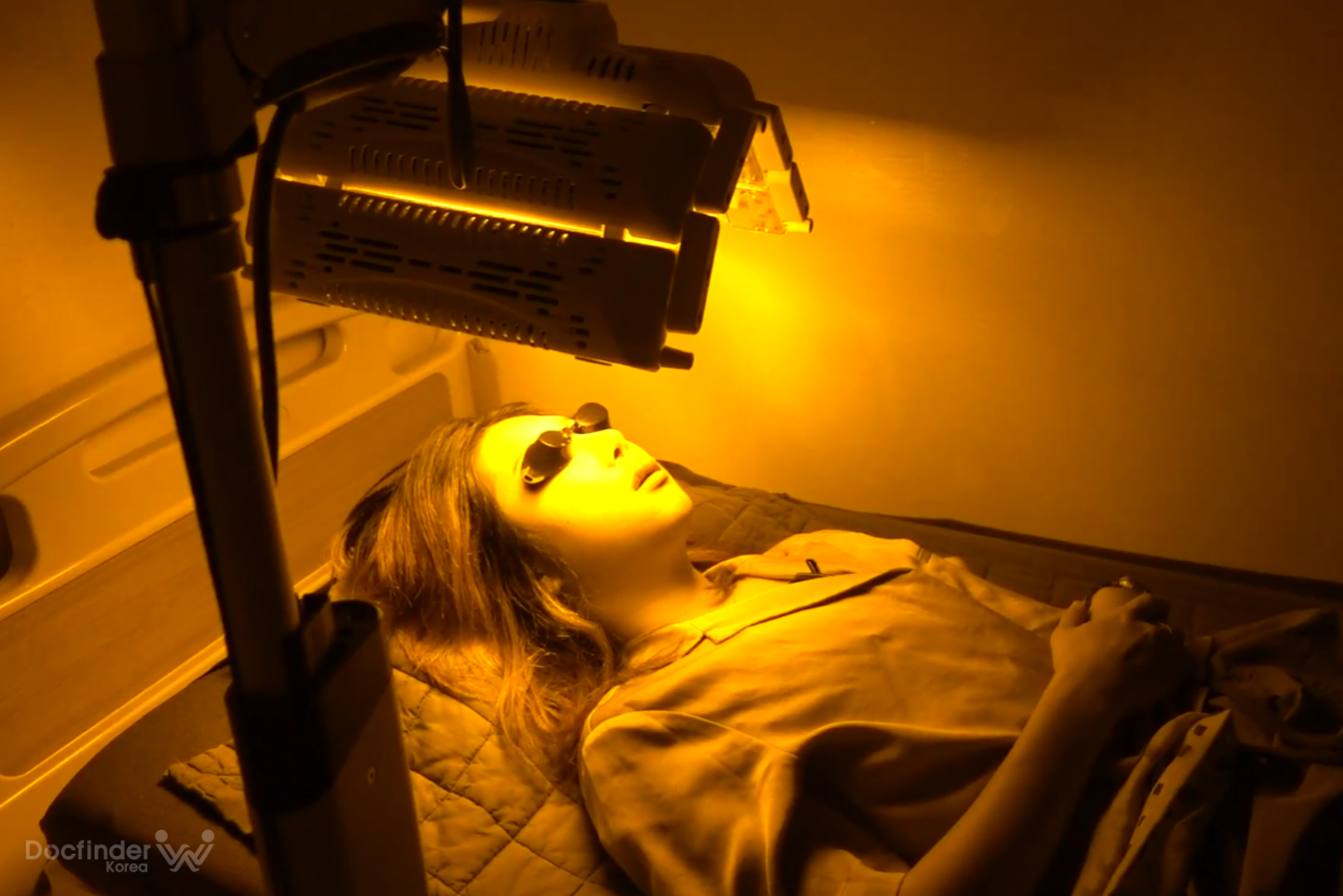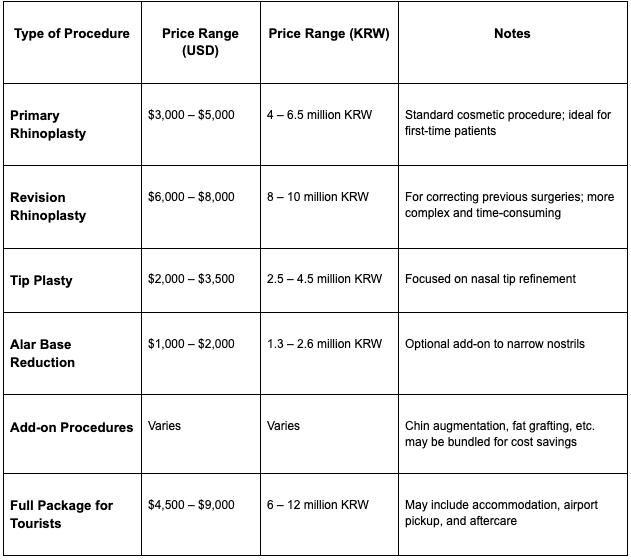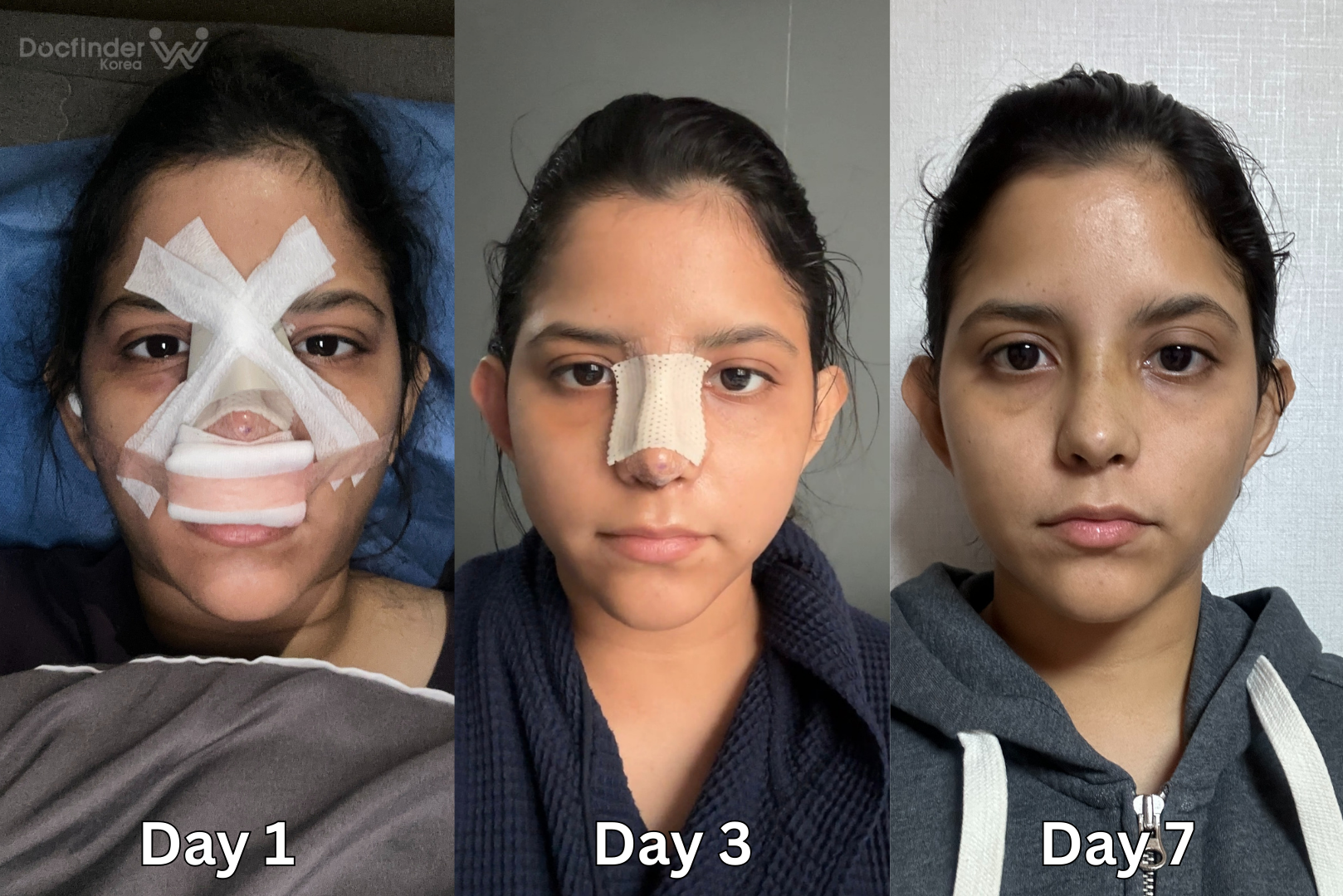Journal
Rhinoplasty in Korea: Your Complete Guide to Nose Surgery in Seoul
2025-08-26
Nose
South Korea has emerged as the global capital of cosmetic surgery, with Seoul's Gangnam district housing more plastic surgery clinics per square mile than anywhere else in the world. If you're considering rhinoplasty, also known as a nose job, Korea offers world-class expertise, innovative techniques, and exceptional value that attracts thousands of international patients annually. This comprehensive guide will walk you through everything you need to know about getting rhinoplasty in Korea, from understanding the procedure to planning your medical journey to Seoul.

What is Rhinoplasty?
Rhinoplasty, commonly referred to as a nose job, is a surgical procedure that reshapes the nose to improve its appearance, function, or both. This sophisticated surgery can address various concerns including the size, shape, angle, and proportion of your nose in relation to your facial features. While many people pursue rhinoplasty for cosmetic enhancement, others seek it to correct breathing problems or repair injuries.
In the context of Korean plastic surgery, rhinoplasty takes on special significance. Asian rhinoplasty, which Korean surgeons have perfected over decades, requires unique techniques and considerations. Unlike Western rhinoplasty that often focuses on reduction, Asian rhinoplasty typically involves augmentation and refinement. Korean surgeons understand the nuances of Asian facial anatomy, including thicker skin, weaker cartilage structures, and the desire for natural-looking results that maintain ethnic identity while enhancing beauty.
The procedure can dramatically improve facial harmony and boost self-confidence. Whether you're looking to refine your nasal tip, straighten a crooked nose, reduce nostril size, or enhance your nasal bridge, Korean rhinoplasty specialists have developed techniques that deliver natural, beautiful results tailored to each patient's unique facial structure and aesthetic goals.
Why Korea for Rhinoplasty?
Korea's dominance in the field of rhinoplasty isn't accidental. The country performs over 600,000 cosmetic procedures annually, with rhinoplasty being one of the most popular surgeries. Korean plastic surgeons complete some of the world's most rigorous training programs, often spending 10-15 years perfecting their craft before establishing independent practices. Many surgeons in Seoul's premier clinics have international certifications and regularly present their innovative techniques at global conferences.
The advanced techniques employed in Korean clinics set them apart from their international counterparts. Korean surgeons pioneered many modern rhinoplasty methods, including the use of autologous materials (your own cartilage) for more natural, long-lasting results. They excel at creating refined, elegant noses that complement Asian features while avoiding the "operated look" that concerns many patients. The success rate for rhinoplasty in Korea stands at approximately 93%, significantly higher than the global average.
Cost efficiency makes Korea particularly attractive for international patients. A comprehensive rhinoplasty procedure in Korea typically costs 40-60% less than comparable surgeries in the United States or Europe, despite offering equivalent or superior quality. When you factor in the advanced technology, surgeon expertise, and comprehensive care packages, the value proposition becomes even more compelling. Many Gangnam clinics also offer all-inclusive packages for international patients that include consultation, surgery, aftercare, and even accommodation assistance.
The concentration of expertise in Seoul, particularly in the Gangnam district, creates a competitive environment that drives innovation and maintains exceptionally high standards. With hundreds of specialized clinics within walking distance of each other, patients have unprecedented access to top-tier surgeons and can easily seek multiple consultations to find their perfect match. This density of expertise has made Seoul the undisputed rhinoplasty capital of Asia and increasingly popular among patients from Europe, the Americas, and the Middle East.
Types of Rhinoplasty in Korea
Korean clinics offer a comprehensive range of rhinoplasty procedures, each tailored to address specific concerns and achieve desired outcomes. Understanding these options helps you make an informed decision about which approach best suits your needs.
Revision Rhinoplasty
Korea has become a global destination for revision rhinoplasty, attracting patients who need corrections from previous surgeries. Korean surgeons' expertise in handling scar tissue, addressing structural complications, and achieving aesthetic improvements in previously operated noses is internationally recognized. Revision cases require exceptional skill and experience, as they often involve working with compromised tissue and limited cartilage availability. The advanced techniques and problem-solving abilities of Korean specialists make them particularly suited for these challenging procedures.
Specialized Procedures
Tip plasty focuses exclusively on reshaping the nasal tip, perfect for patients happy with their bridge but seeking refinement of the tip area. This less invasive procedure offers shorter recovery times while still achieving significant aesthetic improvement. Alar base reduction addresses wide nostrils or flaring, creating better proportion with other facial features. Korean surgeons use precise techniques that minimize scarring while achieving natural-looking nostril shapes.
Septorhinoplasty combines aesthetic improvements with functional corrections, addressing deviated septums or other breathing issues while enhancing appearance. This dual-purpose surgery is particularly popular among patients seeking both medical and cosmetic benefits. Korean surgeons coordinate closely between aesthetic and functional goals, ensuring neither aspect is compromised.
Non-Surgical Options
For patients not ready for surgery or seeking minor adjustments, Korean clinics offer advanced non-surgical rhinoplasty options. Dermal fillers can temporarily augment the nasal bridge, refine the tip, or correct minor asymmetries. Thread lifts provide subtle lifting and contouring effects. While these treatments offer immediate results with no downtime, they're temporary solutions lasting 12-24 months. Many patients use non-surgical options to preview potential surgical results or maintain their appearance between procedures.
The Rhinoplasty Procedure in Korea
Your rhinoplasty journey in Korea begins with a comprehensive consultation, available both in-person and virtually for international patients. During the consultation, your surgeon will evaluate your facial structure, skin thickness, and nasal anatomy while discussing your aesthetic preferences. Many clinics provide translators to ensure clear communication, and surgeons take time to understand not just what you want changed, but what you want preserved about your natural features.
Pre-operative preparation includes comprehensive health screening, typically performed on-site at the clinic. Korean medical facilities maintain hospital-grade standards, with fully equipped operating rooms and recovery facilities. You'll receive detailed instructions about medications to avoid, dietary guidelines, and what to expect on surgery day. Most clinics schedule surgery within 2-3 days of your arrival in Seoul, allowing time for jet lag recovery and final consultations.
The surgery itself typically takes 2-3 hours under general anesthesia or IV sedation, depending on complexity. Korean surgeons are known for their meticulous attention to detail and gentle tissue handling, which contributes to faster healing and better results. During the procedure, your surgeon will make precise adjustments according to the surgical plan, often using your own cartilage from the ear or rib for augmentation when needed. The use of autologous materials is a hallmark of Korean rhinoplasty, providing more natural, long-lasting results with minimal risk of rejection.
Immediately after surgery, you'll recover in a comfortable private room with professional nursing care. Korean clinics pride themselves on their post-operative care, with nurses checking on you regularly and managing any discomfort. Most patients experience minimal pain, controlled effectively with medication. You'll typically stay at the clinic for several hours or overnight, depending on your surgery's extent. Before discharge, you'll receive detailed aftercare instructions, medications, and emergency contact information. Many clinics also provide special pillows, ice packs, and other comfort items to support your recovery.
Recovery & Aftercare
The first 24-48 hours after your rhinoplasty in Korea involve the most significant swelling and potential discomfort. Korean clinics excel at minimizing these effects through advanced surgical techniques and comprehensive aftercare protocols. You'll wear a nasal splint to protect and support your new nose shape, and possibly have soft packing inside your nostrils. Most patients report that discomfort is less than expected, describing it more as pressure than pain. Korean pain management approaches combine medication with traditional methods like specialized ice therapy and lymphatic massage.

Days 3-7 mark a crucial recovery period where swelling peaks and then begins to subside. Korean clinics typically schedule multiple follow-up appointments during this time, providing treatments like LED therapy and ultrasound to accelerate healing. Bruising around the eyes, if present, starts fading by day 5. You'll learn gentle cleaning techniques to maintain hygiene around the surgical site. Many clinics offer specialized recovery programs including vitamin injections and anti-swelling treatments unique to Korean medical practice.
The one-week mark brings significant milestones in your recovery. Your surgeon will remove the splint and any non-dissolvable stitches, revealing your new nose shape for the first time. While swelling continues, you'll see the fundamental changes to your nose structure. Korean surgeons typically clear patients for international travel 10-14 days post-surgery, ensuring you're stable and comfortable for your journey home. Before departure, you'll receive detailed instructions for continued care, prescription medications if needed, and information about virtual follow-ups.
Long-term recovery and aftercare support distinguish Korean rhinoplasty services. Clinics maintain relationships with international patients through messaging apps, video consultations, and detailed recovery timelines. Swelling continues to decrease over several months, with final results visible after one year. Korean clinics often provide lifetime consultation services, addressing any concerns that arise during healing. Many also coordinate with medical professionals in your home country if local follow-up care is needed. The comprehensive aftercare approach ensures optimal results and provides peace of mind throughout your recovery journey.
Cost of Rhinoplasty in Korea

Rhinoplasty costs in Korea range from $3,000 to $8,000 USD (approximately 4 to 10 million KRW), depending on the complexity of your case and the specific techniques required. Primary rhinoplasty typically falls in the $3,000-$5,000 range, while revision surgeries or complex reconstructions may reach $6,000-$8,000. These prices include the surgeon's fee, anesthesia, operating room costs, and basic aftercare, representing exceptional value compared to Western countries where similar procedures cost $8,000-$15,000 or more.
Several factors influence the final cost of your rhinoplasty in Korea. The surgeon's experience and reputation naturally affect pricing, with renowned specialists commanding premium fees. The complexity of your case plays a significant role; procedures requiring rib cartilage harvesting or extensive reconstruction cost more than simple tip refinements. The choice between primary and revision surgery impacts price, as revision cases demand greater expertise and longer operating times. Additional procedures performed simultaneously, such as chin augmentation or fat grafting, can provide cost savings compared to separate surgeries.
When comparing costs internationally, Korea's value proposition becomes clear. A rhinoplasty that costs $12,000 in Beverly Hills or $10,000 in London can be performed in Seoul for $4,500 with comparable or superior results. This isn't about cutting corners; Korean clinics invest heavily in technology, training, and facilities. The cost efficiency comes from the competitive market, favorable exchange rates, and Korea's efficient healthcare system. Even accounting for travel expenses and accommodation, most international patients save thousands while accessing world-class surgical expertise.
It's important to remember that each rhinoplasty is unique, and quoted prices should be considered estimates until your consultation. Factors like your nasal anatomy, skin thickness, and aesthetic goals all influence the surgical approach and associated costs. We encourage you to contact our team for a personalized quote based on your specific needs. Many Korean clinics offer flexible payment plans and package deals for international patients that include accommodations, airport transfers, and comprehensive aftercare, making the financial aspect of your medical journey more manageable.
Rhinoplasty Before and After: Real Patient Results
Seeing real results is one of the best ways to understand what rhinoplasty in Korea can achieve. Below are actual before-and-after photos of our patients from around the world. These cases show a range of procedures — from subtle refinements to dramatic transformations — performed by our experienced surgeons here in Seoul.

Please note: All patients have provided consent for their images to be shown. Individual results vary.
Travel Tips for Patients
Planning your medical journey to Seoul requires careful coordination, but Korean clinics have streamlined the process for international patients. Most visitors arrive at Incheon International Airport, consistently ranked among the world's best airports, located about an hour from Seoul's Gangnam district. The airport offers excellent connections to the city via express train, airport limousine buses, or taxi services. Many clinics provide airport pickup services, ensuring a smooth transition from arrival to your accommodation. The journey from Incheon to Gangnam takes approximately 60-90 minutes, giving you time to rest and prepare for your Korean medical experience.
Choosing accommodation in Seoul strategically enhances your recovery experience. The Gangnam district offers the highest concentration of plastic surgery clinics, making it the ideal base for your stay. Hotels and serviced apartments in Gangnam range from budget-friendly options at $50 per night to luxury accommodations exceeding $200. Many clinics have partnerships with nearby hotels offering medical tourism packages with special rates and amenities suited for recovering patients. Staying within walking distance or a short taxi ride from your clinic minimizes travel stress during follow-up appointments.
Most international patients should plan to stay in Korea for 10-14 days total. This timeframe allows for initial consultation, surgery, primary recovery, splint removal, and clearance for international travel. Citizens of many countries, including the United States, Canada, and most European nations, can enter Korea visa-free for up to 90 days, simplifying travel planning. However, verify current visa requirements for your nationality before booking. Consider purchasing travel insurance that covers medical tourism, and inform your provider about your planned procedure.
Language barriers need not concern you when seeking rhinoplasty in Korea. Major clinics in Gangnam employ multilingual staff and provide translation services in English, Chinese, Japanese, and often Arabic or Russian. Medical documents, consent forms, and aftercare instructions are available in multiple languages. Many Korean surgeons have trained internationally and speak fluent English. Download translation apps and save your clinic's contact information in both English and Korean for emergencies. Korean hospitality culture ensures international patients feel welcomed and supported throughout their stay. The country's excellent public transportation, widespread English signage in tourist areas, and helpful locals make navigation manageable even for first-time visitors.
FAQs
Q: How painful is rhinoplasty recovery?
A: Most patients report minimal pain after rhinoplasty in Korea, rating discomfort at 3-4 out of 10. Korean surgeons use advanced techniques that minimize tissue trauma, and comprehensive pain management protocols keep you comfortable. The sensation is typically described as pressure or stuffiness rather than sharp pain.
Q: Is rhinoplasty in Korea safe for foreigners?
A: Absolutely. Korean medical standards meet or exceed international benchmarks, with clinics maintaining strict safety protocols and hygiene standards. Surgeons are highly trained, facilities are modern and well-equipped, and the country has an excellent medical safety record. Many clinics are internationally accredited and regularly treat foreign patients.
Q: Will I have visible scars after rhinoplasty?
A: Scarring depends on your procedure type. Closed rhinoplasty leaves no visible scars as all incisions are internal. Open rhinoplasty creates a small scar on the columella that typically fades to near-invisibility within 6-12 months. Korean surgeons are particularly skilled at minimizing and concealing scars.
Q: What about the language barrier during my surgery and recovery?
A: Major Korean rhinoplasty clinics are well-equipped to serve international patients. They provide professional medical interpreters, translated documents, and multilingual staff. Your surgeon and medical team will ensure clear communication throughout your journey.
Q: How soon can I fly home after rhinoplasty?
A: Most surgeons clear patients for international flights 3 days post-surgery. By this time, initial healing is progressing well, and the risk of complications from air travel is minimal. You may also choose to stay until 7 days post-surgery to have your splint and stitches removed before leaving.
Q: Can I combine rhinoplasty with other procedures?
A: Yes, many patients choose to combine rhinoplasty with other facial procedures like chin augmentation, fat grafting, or eyelid surgery. Combining procedures can be cost-effective and reduces overall recovery time compared to separate surgeries. Your surgeon will advise on safe combinations based on your health and goals.
Q: What if I need revision or have complications after returning home?
A: Korean clinics provide extensive remote aftercare support via messaging apps and video consultations. They can coordinate with medical professionals in your country if needed. Many clinics offer revision policies and will address any concerns, though the need for revision is rare given Korea's high success rates.
Conclusion
Choosing rhinoplasty in Korea means accessing world-leading surgical expertise, innovative techniques, and exceptional value in the heart of Seoul. The combination of highly skilled surgeons, advanced medical technology, and comprehensive patient care has established Korea as the premier destination for nose surgery in Asia and increasingly for patients worldwide. Whether you're seeking subtle refinement or dramatic transformation, Korean rhinoplasty specialists have the expertise to achieve natural, beautiful results tailored to your unique facial features and aesthetic goals.
The journey to your new nose begins with a single step. From your initial consultation through your recovery and beyond, Korean clinics provide the support, expertise, and care you need for a successful transformation. The investment in rhinoplasty extends beyond physical appearance, often bringing increased confidence and improved quality of life. With Seoul just a flight away and clinics ready to guide international patients through every step, there's never been a better time to explore how Korean rhinoplasty can help you achieve the nose you've always wanted.
Ready to start your rhinoplasty journey in Korea?
Contact our team for a personalized consultation and discover how we can help you achieve your aesthetic goals. Our international patient coordinators are standing by to answer your questions, provide detailed information about our procedures, and help you plan your medical journey to Seoul. View our rhinoplasty before and after photos to see the transformative results our surgeons achieve, and take the first step toward the confident, beautiful you.
Back



